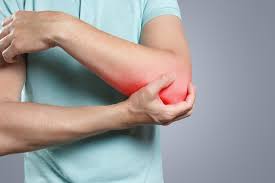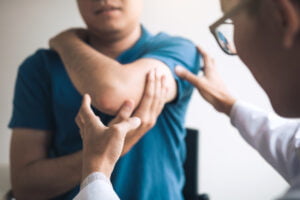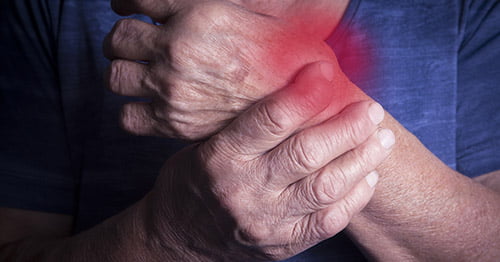Lupus, an autoimmune disease, affects millions of people worldwide. It can manifest in various ways, and one common symptom experienced by lupus patients is elbow pain. In this article, we will explore the relationship between lupus and elbow pain, delve into the causes and diagnosis, and offer valuable insights into managing and coping with this challenging aspect of the disease.
Contents
Understanding Lupus
Lupus is a chronic autoimmune disorder where the body’s immune system mistakenly attacks healthy tissues, leading to inflammation and damage in various organs and systems. The most common type is systemic lupus erythematosus (SLE), but there are other forms like discoid lupus and drug-induced lupus.
Types of Lupus

Lupus, or systemic lupus erythematosus (SLE), is the most common form of lupus, but there are several other types of lupus and related conditions that can affect individuals. The main types of lupus include:
Systemic Lupus Erythematosus (SLE): This is the most common and well-known form of lupus. It is an autoimmune disease that can affect multiple organs and tissues throughout the body, leading to a wide range of symptoms. SLE can cause inflammation in the joints, skin, kidneys, brain, heart, and other organs.
Cutaneous Lupus Erythematosus (CLE): Cutaneous lupus primarily affects the skin. There are three main subtypes of CLE:
- Discoid Lupus Erythematosus (DLE): Characterized by round, red skin rashes that may scar or cause skin discoloration.
- Subacute Cutaneous Lupus Erythematosus (SCLE): Presents with skin rashes that are more photosensitive and often appear as annular (ring-shaped) lesions.
- Acute Cutaneous Lupus Erythematosus (ACLE): Typically occurs during lupus flares and causes a butterfly-shaped rash across the cheeks and nose (malar rash).
Drug-Induced Lupus Erythematosus (DILE): This type of lupus is triggered by certain medications. Symptoms are similar to SLE but usually, resolve when the medication is discontinued.
Common Symptoms of Lupus
Lupus, also known as systemic lupus erythematosus (SLE), is an autoimmune disease that can affect various parts of the body. The symptoms of lupus can vary widely among individuals, and they may come and go over time. Some common symptoms of lupus include:
- Fatigue: Persistent and overwhelming fatigue is one of the most common symptoms of lupus, and it can significantly impact a person’s quality of life.
- Joint pain and swelling: Lupus can cause joint pain, stiffness, and swelling, which may be similar to arthritis.
- Skin rashes: A characteristic butterfly-shaped rash across the cheeks and nose (malar rash) is often associated with lupus. Other skin rashes and sensitivity to sunlight (photosensitivity) may also occur.
- Fever: Many people with lupus experience recurrent low-grade fevers or fever spikes.
- Muscle pain: Muscle aches and weakness are common symptoms, which may be mistaken for fibromyalgia in some cases.
- Raynaud’s phenomenon: Fingers and toes may turn white or blue in response to cold temperatures or stress due to restricted blood flow (Raynaud’s phenomenon).
- Chest pain: Lupus can cause inflammation of the lining around the heart (pericarditis) or lungs (pleuritis), leading to chest pain that worsens with deep breathing.
The Link Between Lupus and Elbow Pain

Elbow pain can be associated with lupus, especially in individuals who have active inflammation or joint involvement due to the autoimmune disease. Lupus is known to cause musculoskeletal symptoms, and joint pain can be a significant part of this.
Here’s how lupus can be linked to elbow pain:
- Arthritis: Lupus can cause a form of arthritis known as “Lupus Arthritis” or “Lupus Arthropathy.” This condition leads to inflammation in the joints, including the elbows, resulting in pain, swelling, stiffness, and reduced range of motion.
- Tendonitis: Lupus can also cause inflammation of the tendons, a condition known as tendonitis. If the tendons around the elbow are affected, it can lead to pain and discomfort in that area.
- Bursitis: Inflammation of the bursa sacs, which are fluid-filled sacs that cushion the joints, can occur in lupus. If the bursa around the elbow is inflamed, it can lead to elbow pain.
- Raynaud’s Phenomenon: Some individuals with lupus may experience Raynaud’s phenomenon, where blood flow to the extremities, including the arms, can be reduced in response to cold or stress. This reduced blood flow can cause pain and discomfort in the elbows.
- Other Causes: It’s essential to remember that not all elbow pain in people with lupus is directly related to the disease. Lupus can increase a person’s susceptibility to musculoskeletal issues and injuries, and elbow pain could be caused by overuse, strain, or other unrelated conditions.
Diagnosing Lupus-Related Elbow Pain
Diagnosing lupus-related elbow pain involves a comprehensive evaluation by a healthcare provider, typically a rheumatologist, who specializes in autoimmune diseases like lupus. Lupus can present with a wide range of symptoms, and the diagnosis process may include the following steps:
- Medical History and Physical Examination: The healthcare provider will start by taking a detailed medical history, including any family history of autoimmune diseases. They will inquire about the nature and duration of the elbow pain, along with any other associated symptoms. During the physical examination, the doctor will assess the affected joints, looking for signs of inflammation, tenderness, swelling, and limited range of motion.
- Blood Tests: Blood tests are essential in diagnosing lupus. The most common blood test is the antinuclear antibody (ANA) test, which is positive in the majority of people with lupus. However, a positive ANA test alone does not confirm lupus since it can be positive in other conditions as well. Other specific blood tests may be ordered, including anti-dsDNA antibodies, anti-Sm antibodies, anti-Ro/SSA, anti-La/SSB antibodies, and others, to help establish a lupus diagnosis.
- Additional Laboratory Tests: Depending on the symptoms and findings, the doctor may request other blood tests to assess inflammation levels (e.g., ESR and CRP), complete blood count (CBC), kidney function, and liver function.
- Imaging: X-rays or other imaging studies may be ordered to examine the affected joints, including the elbows, to check for signs of arthritis, joint damage, or other abnormalities.
- Biopsy: In some cases, if skin rashes are present, a skin biopsy may be performed to examine the skin tissue under a microscope, which can help in the diagnosis of cutaneous lupus.
Managing Lupus-Related Elbow Pain
These are some of the treatment methods related to elbow pain:
Medications and Pain Relief Various medications, including nonsteroidal anti-inflammatory drugs (NSAIDs) and disease-modifying antirheumatic drugs (DMARDs), can help manage pain and inflammation.
Lifestyle Changes and Physical Therapy Adopting a healthy lifestyle and engaging in physical therapy can improve joint function and alleviate elbow pain.
Complementary and Alternative Therapies Complementary treatments like acupuncture and yoga, when combined with conventional treatments, may offer additional relief.
Tips for Coping with Elbow Pain

Coping with elbow pain can be challenging, but various strategies and lifestyle adjustments can help manage discomfort and improve the overall quality of life. Here are some tips for coping with elbow pain:
- Rest the Elbow: Give your elbow time to rest and avoid activities that worsen the pain or put a strain on the joint. Rest can help reduce inflammation and promote healing.
- Use Ice or Heat Packs: Applying ice packs can help reduce swelling and numb the area to alleviate pain. Alternatively, using heat packs can relax tense muscles and promote blood circulation to aid in healing. Apply ice or heat for about 15-20 minutes at a time, several times a day as needed.
- Pain Medication: Over-the-counter pain relievers, such as acetaminophen or non-steroidal anti-inflammatory drugs (NSAIDs), can help manage mild to moderate elbow pain. Always follow the recommended dosage and consult your doctor if you have any health conditions or concerns.
- Compression and Elevation: Using a compression bandage or sleeve around the elbow joint can help reduce swelling. Elevating the affected arm on a pillow or cushion when resting can also minimize swelling.
Maintaining Overall Joint Health with Lupus
Support and community play a crucial role in various aspects of our lives, providing numerous benefits to our physical, emotional, and mental well-being. Whether it’s during times of difficulty, personal growth, or celebration, having a strong support network and a sense of belonging to a community can make a significant difference. Here are some reasons why support and community are important:
- Emotional Support: Having people who genuinely care about us and our well-being can provide emotional support during challenging times. They can lend a listening ear, offer empathy, and help us process our feelings and emotions, reducing feelings of isolation and loneliness.
- Stress Reduction: Being part of a supportive community can help reduce stress by providing a sense of security and comfort. Knowing that there are people who have our backs can alleviate anxiety and provide a buffer against life’s challenges.
The Importance of Support and Community
Support and community play a crucial role in various aspects of our lives, providing numerous benefits to our physical, emotional, and mental well-being. Whether it’s during times of difficulty, personal growth, or celebration, having a strong support network and a sense of belonging to a community can make a significant difference. Here are some reasons why support and community are important:
1. Emotional Support: Having people who genuinely care about us and our well-being can provide emotional support during challenging times. They can lend a listening ear, offer empathy, and help us process our feelings and emotions, reducing feelings of isolation and loneliness.
2. Stress Reduction: Being part of a supportive community can help reduce stress by providing a sense of security and comfort. Knowing that there are people who have our backs can alleviate anxiety and provide a buffer against life’s challenges.
3. Improved Mental Health: Social connections are closely linked to better mental health. Being part of a community can foster a sense of purpose, boost self-esteem, and provide opportunities for meaningful interactions, all of which contribute to improved mental well-being.
Conclusion
Living with lupus and elbow pain can be challenging, but with early diagnosis, a comprehensive treatment plan, and a strong support network, patients can find relief and lead fulfilling lives. Remember, no two journeys are the same, and seeking support and information can make a significant difference in managing this condition.
If you’re experiencing Elbow pain, physical therapy for elbow pain at PhysioMantra can help: Book an online physical therapy session.



